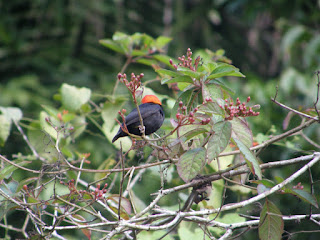The lodge is situated in several hundred acres of rainforest, immediately adjacent to the Tapir national reserve, and had birds in abundance. We even saw a tapir track - and a tarantula. But this is supposed to be a bird blog, so on we go.
 I'm fairly sure this first bird is a hooded warbler. The facial markings are very distinctive, which helps, and it's said to be a common winter bird. But my copy of H Lee Jones "Birds of Belize" suggests that the whole of the bird's body is a uniform olive green, while this one is clearly olive green shading into grey.
I'm fairly sure this first bird is a hooded warbler. The facial markings are very distinctive, which helps, and it's said to be a common winter bird. But my copy of H Lee Jones "Birds of Belize" suggests that the whole of the bird's body is a uniform olive green, while this one is clearly olive green shading into grey.
We saw three of these next birds together, but only one of them stayed still long enough to be photographed. This is a black headed saltator. Again the colouration on the birds we saw seemed slightly different from what the bird book suggests. This is olive green above, yellow below with a grey head and darker grey patches around the eyes. The book suggests "grey and cinnamon" below, whereas the plumange on the birds we saw was definitely lemon yellow underneath. Evens so: it's a large bird, travelling in groups, with a distinctive beak shape, so I'm fairly sure of the indentification.

No doubts about this next one. A red capped manakin - a small black bird with a very distinctive red head. It really does look as though it's wearing a read hood or cap.

So to what for us were the highlights of the trip. These next shots are of the collared aracari. We saw lots of these, both singly and in groups of three or four. The distinctive bill shows it to be one of the toucan family, and these were the first toucans we'd seen outside the zoo.


Which leaves, last but by no means least, the keel billed toucan. We've waited a long time to see one of these, and thought we would be disappointed this time too. But towards evening, one came and settled to feed where we could see it. This toucan is the national bird of Belize. It was some distance away - close to the limits for our camera - but unmistakeable and wonderful. Hope you enjoy the photos. We enjoyed taking them.




































